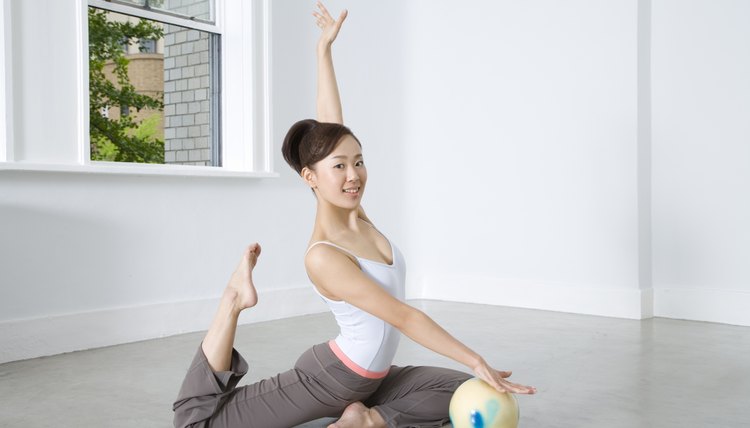List of Gymnastic Events

There are three primary types of gymnastic competitions: artistic, rhythmic and acrobatic. Each is a separate sport. Artistic gymnastics are generally known as just "gymnastics." Men's and women's gymnastics include two common events, the floor exercise and the vault. Otherwise, the sport varies for male and female competitors. Men compete in six events, and women compete in four.
Vault
The vault features a runway, a springboard, the vault table and the landing area. The vault table is about four feet tall. Competitors sprint to the springboard, launch off of it, push off the vault table and perform various aerial maneuvers. Judging is based on form, body alignment, repulsion, height, distance and the number and difficulty of the twists and saltos. The more elaborate the body movement, the higher the difficulty value is for the vault. As in other events, gymnasts want to "stick" their landing and avoid taking extra steps. Shannon Miller, a seven-time Olympic medalist, summed up her mental approach to the vault in an interview with Gymnastike: "Power down the runway, stick the landing, that's all you have to do."
Floor Exercise
Competitors in the floor exercise choreograph their routines to music. A good floor exercise blends dance elements and tumbling. Pirouettes, leaps and turns are converted from mere gymnastic techniques into dazzling displays of prowess. Dance plus athleticism makes the routine exciting to watch.
Balance Beam
The balance beam stands about four feet off the ground in this women's event. The beam is just four inches wide. Gymnasts must execute a variety of difficult maneuvers as if they were performing on the floor. While beginners may be tentative on the beam, world-class gymnasts confidently attack it with their routines. "I was intimidated by everything, except being on the balance beam," Miller told the Celebrity Baby Scoop website. "Sometimes, you have to almost trick yourself into being self confident. I learned to fake confidence once I walked onto the floor mat in a competition and realized later that I actually felt more confident."
Uneven Bars
The low bar is set about 5 feet, 4 inches off the ground for this women's event. The high bar is about eight feet high. The bars are approximately six feet apart. The routine is scored on the gymnast's ability to flow seamlessly from one move to the next without pausing. One of the most stunning-to-watch aspects is the flow from the high bar to the low or vice versa. These daring moves showcase the gymnast's strength and versatility.
Pommel Horse
This apparatus stands about 3 feet, 8 inches high for this men's event. It demands tremendous strength in order for the gymnast to support himself by his hands alone above the horse in a series of circular movements. With only the break of the scissor-like movements of the legs, until the routine is complete, the athlete is in constant motion.
Parallel Bars
The parallel bars are about 6 feet, 4 inches high. Gymnasts must execute a variety of swings in a successful parallel bars routine. The double front or back salto are moves that cause the gymnast to lose sight of the bars for a few seconds and are considered some of the most difficult moves. This men's event is physically demanding; Olympic medalist Paul Hamm broke his hand performing it. "It's just something you can't ever totally avoid," he told Inside Gymnastics Magazine. "You're putting yourself out there and, in those situations, you can be injured. It's something that can happen at any moment. I've seen it happen. I've seen it happen to me."
Still Rings
The still rings hang from a tower that's about 19 feet tall. The rings hang on cables that are nearly 10 feet long. The cables are slightly less than 20 inches apart. This men's event demands tremendous strength, since competitors must keep the rings still and under control as they finish maneuvers. To get top scores, gymnasts must keep their bodies straight and their arms strong, with no shaking.
Horizontal Bar
The horizontal bar stands about nine feet tall for this men's event. It is known for its high-flying dismounts that allow a very small margin of error. The dismount is often the star of the show as everyone catches their breath watching the athlete fly 12 to 15 feet over the bar. One of the biggest moves that the gymnast will train for over and over is the landing which must be "stuck"; in other words no staggering forward after their feet hit the mat.
Writer Bio
Jeff Gordon has been reporting and writing since 1977. His most recent work has appeared on websites such as eHow, GolfLink, Ask Men, Open Sports, Fox Sports and MSN. He has previously written for publications such as "The Sporting News" and "The Hockey News." He graduated from the University of Missouri-Columbia School of Journalism in 1979 with a bachelor's degree.
